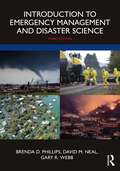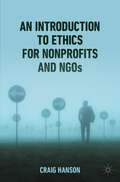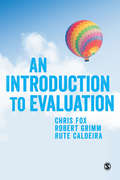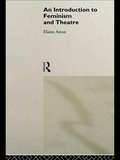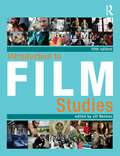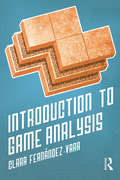- Table View
- List View
Introduction to Emergency Management and Disaster Science
by Brenda D. Phillips David M. Neal Gary R. WebbA definitive resource, the Introduction to Emergency Management and Disaster Science presents the essentials to better understand and manage disasters. The third edition of this popular text has been revised and updated to provide a substantively enriched and evidence-based guide for students and emerging professionals. The new emphasis on disaster science places it at the forefront of a rapidly evolving field. This third edition offers important updates, including: Newly commissioned insights from former students and professional colleagues involved with emergency management practice and disaster science; international policies, programs, and practices; and socially vulnerable populations. Significantly enriched content and coverage of new disasters and recent research, particularly the worldwide implications of climate change and pandemics. Pedagogical features like chapter objectives, key terms and definitions, discussion points and resources. The only textbook authored by three winners of the Blanchard Award for excellence in emergency management instruction. Online Support Material with instructional videos containing practical information and learning objectives for the next generation of emergency managers and disaster scientists. The Introduction to Emergency Management and Disaster Science is a must-have textbook for graduate and undergraduate students and is also an excellent source of information for researchers and professionals.
An Introduction to Environment, Society and Sustainability
by Helen Hazen Paul SuttonThis timely and innovative book delves into the complex interplay of human activities and natural limits in generating today’s sustainability challenges. By contrasting the pressures of growing populations with ecological footprints associated with consumption, the volume navigates the contested terrain where human societies generate environmental impacts.Adorned with illustrative figures, examples and case studies throughout, this book presents insightful analysis of ecological, economic, technological, and social justice responses to the challenges faced by human civilization, including land degradation, climate change, pollution, and overexploitation of natural resources. Many of these issues are wicked problems, characterized by incomplete information, multiple stakeholders, and contested approaches to addressing them. In simple terms, sustainability issues are an interplay between population growth and rising consumption, which are placing impossible demands on finite resources. Potential solutions to the crisis are split between green growth approaches that emphasize technology and institutional capacity to guide economic growth in more sustainable ways, and degrowth approaches that call for a fundamental rethinking of the way we structure society and generate value. This book emerged from a student seminar where undergraduate and graduate students highlighted sustainability topics of concern, helped consider their framing, and then assisted with co-writing several of the chapters. The volume encourages readers to consider structural questions that underpin sustainability dilemmas, and begins with four theoretical frameworks for understanding sustainability issues: ideas from the natural sciences, the population/consumption debate, economic frameworks, and ethical approaches. It then uses a systems approach to apply these theoretical ideas to complex global systems such as the atmosphere, oceans, and agriculture.This volume will be of pivotal interest to students, scholars and academics in the fields of environmental studies, environment and society, human geography and environmental geography, as well as those with an interest in these areas more generally.
An Introduction to Environment, Society and Sustainability
by Helen Hazen Paul SuttonThis timely and innovative book delves into the complex interplay of human activities and natural limits in generating today’s sustainability challenges. By contrasting the pressures of growing populations with ecological footprints associated with consumption, the volume navigates the contested terrain where human societies generate environmental impacts.Adorned with illustrative figures, examples and case studies throughout, this book presents insightful analysis of ecological, economic, technological, and social justice responses to the challenges faced by human civilization, including land degradation, climate change, pollution, and overexploitation of natural resources. Many of these issues are wicked problems, characterized by incomplete information, multiple stakeholders, and contested approaches to addressing them. In simple terms, sustainability issues are an interplay between population growth and rising consumption, which are placing impossible demands on finite resources. Potential solutions to the crisis are split between green growth approaches that emphasize technology and institutional capacity to guide economic growth in more sustainable ways, and degrowth approaches that call for a fundamental rethinking of the way we structure society and generate value. This book emerged from a student seminar where undergraduate and graduate students highlighted sustainability topics of concern, helped consider their framing, and then assisted with co-writing several of the chapters. The volume encourages readers to consider structural questions that underpin sustainability dilemmas, and begins with four theoretical frameworks for understanding sustainability issues: ideas from the natural sciences, the population/consumption debate, economic frameworks, and ethical approaches. It then uses a systems approach to apply these theoretical ideas to complex global systems such as the atmosphere, oceans, and agriculture.This volume will be of pivotal interest to students, scholars and academics in the fields of environmental studies, environment and society, human geography and environmental geography, as well as those with an interest in these areas more generally.
An Introduction to Ethics for Nonprofits and NGOs
by Craig HansonThis textbook explores ethical issues for not-for-profit and non-governmental organizations, providing discussion-oriented cases for NFP and NGP practitioners. The book begins with an introduction to professional ethics as practiced in industry, not-for-profits and NGO’s. Attention is paid both to classical ethical theories and contemporary variants. Then, combining that theory with an introduction to the morally unique facets of the NFP and NGO landscape, it offers a series of cases which pertain to the underlying theoretical substrate. The reader will find a blend of theory and application within the text as well as guided assignment prompts. Themes covered include board relationships, staff management, work with vulnerable populations, financial transparency, Human Resources ethics and ethical dilemmas unique to international operations.
An Introduction to Evaluation
by Professor Chris Fox Rute Caldeira Robert GrimmBoth practical and theoretical in approach, this book is the perfect companion for student researchers and policy makers alike. It provides actionable advice for planning and implementing evaluations, while also instilling an ability to assess the evaluations of others and consider the ways in which evaluation evidence could influence policy and practice. Drawing upon a wide range of examples from policy areas like education, criminal justice, and health and social care, this book showcases how evaluation is an interdisciplinary research practice with a spectrum of applications. Each chapter contains philosophical underpinnings and applied knowledge as well as examples from published evaluations. Specific topics include how to: Choose an approach to evaluation Plan, design, and conduct evaluations Approach evaluations using theories of change Differentiate between process, impact, and economic evaluations Understand the role of quantitative and qualitative methods in data collection Use systematic reviews and other tools to assess and disseminate evaluation findings From getting started in the field to turning evidence into policy, this book will guide you through every step of the evaluation process.
An Introduction to Evaluation
by Professor Chris Fox Rute Caldeira Robert GrimmBoth practical and theoretical in approach, this book is the perfect companion for student researchers and policy makers alike. It provides actionable advice for planning and implementing evaluations, while also instilling an ability to assess the evaluations of others and consider the ways in which evaluation evidence could influence policy and practice. Drawing upon a wide range of examples from policy areas like education, criminal justice, and health and social care, this book showcases how evaluation is an interdisciplinary research practice with a spectrum of applications. Each chapter contains philosophical underpinnings and applied knowledge as well as examples from published evaluations. Specific topics include how to: Choose an approach to evaluation Plan, design, and conduct evaluations Approach evaluations using theories of change Differentiate between process, impact, and economic evaluations Understand the role of quantitative and qualitative methods in data collection Use systematic reviews and other tools to assess and disseminate evaluation findings From getting started in the field to turning evidence into policy, this book will guide you through every step of the evaluation process.
An Introduction To Feminism And Theatre
by Elaine AstonAt last an accessible and intelligent introduction to the energising and challenging relationship between feminism and theatre. In this clear and enlightening book, Aston discusses wide-ranging theoretical topics and provides case studies including: * Feminism and theatre history * `M/Othering the self': French feminist theory and theatre * Black women: shaping feminist theatre * Performing gender: a materialist practice * Colonial landscapes Feminist thought is changing the way theatre is taught and practiced. An Introduction to Feminism and Theatre is compulsory reading for anyone who requires a precise, insightful and up-to-date guide to this dynamic field of study. 9781138683006 / 9781315626055
An Introduction to Feminism and Theatre (PDF)
by Elaine AstonAt last an accessible and intelligent introduction to the energising and challenging relationship between feminism and theatre. In this clear and enlightening book, Aston discusses wide-ranging theoretical topics and provides case studies including: * Feminism and theatre history * `M/Othering the self': French feminist theory and theatre * Black women: shaping feminist theatre * Performing gender: a materialist practice * Colonial landscapes Feminist thought is changing the way theatre is taught and practiced. An Introduction to Feminism and Theatre is compulsory reading for anyone who requires a precise, insightful and up-to-date guide to this dynamic field of study. 0415087686 / 0415087694
An Introduction To Feminist Philosophy
by Alison StoneThis is the first book to offer a systematic account of feminist philosophy as a distinctive field of philosophy. The book introduces key issues and debates in feminist philosophy including: the nature of sex, gender, and the body; the relation between gender, sexuality, and sexual difference; whether there is anything that all women have in common; and the nature of birth and its centrality to human existence. An Introduction to Feminist Philosophy shows how feminist thinking on these and related topics has developed since the 1960s. The book also explains how feminist philosophy relates to the many forms of feminist politics. The book provides clear, succinct and readable accounts of key feminist thinkers including de Beauvoir, Butler, Gilligan, Irigaray, and MacKinnon. The book also introduces other thinkers who have influenced feminist philosophy including Arendt, Foucault, Freud, and Lacan. Accessible in approach, this book is ideal for students and researchers interested in feminist philosophy, feminist theory, women's studies, and political theory. It will also appeal to the general reader.
Introduction to Film Studies
by Jill NelmesIntroduction to Film Studies is a comprehensive textbook for students of cinema. This completely revised and updated fifth edition guides students through the key issues and concepts in film studies, traces the historical development of film and introduces some of the worlds key national cinemas. A range of theories and theorists are presented from Formalism to Feminism, from Eisenstein to Deleuze. Each chapter is written by a subject specialist, including two new authors for the fifth edition. A wide range of films are analysed and discussed. It is lavishly illustrated with 150 film stills and production shots, in full colour throughout. Reviewed widely by teachers in the field and with a foreword by Bill Nichols, it will be essential reading for any introductory student of film and media studies or the visual arts worldwide. Key features of the fifth edition are: updated coverage of a wide range of concepts, theories and issues in film studies in-depth discussion of the contemporary film industry and technological changes new chapters on Film and Technology and Latin American Cinema new case studies on films such as District 9, Grizzly Man, Amores Perros, Avatar, Made in Dagenham and many others marginal key terms, notes, cross-referencing suggestions for further reading, further viewing and a comprehensive glossary and bibliography a new, improved companion website including popular case studies and chapters from previous editions (including chapters on German Cinema and The French New Wave), links to supporting sites, clips, questions and useful resources. Individual chapters include: The Industrial Contexts of Film Production · Film and Technology · Getting to the Bigger · Picture Film Form and Narrative · Spectator, Audience and Response · Cinematic authorship and the film auteur · Stardom and Hollywood Cinema · Genre, Theory and Hollywood Cinema The Documentary Form · The Language of Animation · Gender and Film · Lesbian and Gay Cinema · Spectacle, Stereotypes and Films of the African Diaspora · British Cinema · Indian Cinema · Latin American Cinema · Soviet Montage Cinema of the 1920s Contributors: Linda Craig, Lalitha Gopalan, Terri Francis, Chris Jones, Mark Joyce, Searle Kochberg, Lawrence Napper, Jill Nelmes, Patrick Phillips, Suzanne Speidel, Paul Ward, Paul Watson, Paul Wells and William Wittington
Introduction to Forensic Anthropology
by Steven N. ByersThis book provides comprehensive coverage of the methods and issues in the current practice of forensic anthropology. It introduces students to all the major topics in the field, with material ranging from the attribution of ancestry and sex, to various forms of bone trauma, to identification through radiography. Introduction to Forensic Anthropology uses the terminology and best practices recommended by the Scientific Working Group for Forensic Anthropology (SWGANTH). The fifth edition has been fully updated in light of recent developments, incorporating new and improved methods as well as fresh data. The section on human osteology and odontology in particular has been expanded. This accessible and engaging text offers an array of features to support teaching and learning, including: boxed case studies extensive figures and photographs chapter summaries and student exercises a glossary of terms further resources via a companion website.
Introduction to Forensic Anthropology
by Steven N. ByersThis book provides comprehensive coverage of the methods and issues in the current practice of forensic anthropology. It introduces students to all the major topics in the field, with material ranging from the attribution of ancestry and sex, to various forms of bone trauma, to identification through radiography. Introduction to Forensic Anthropology uses the terminology and best practices recommended by the Scientific Working Group for Forensic Anthropology (SWGANTH). The fifth edition has been fully updated in light of recent developments, incorporating new and improved methods as well as fresh data. The section on human osteology and odontology in particular has been expanded. This accessible and engaging text offers an array of features to support teaching and learning, including: boxed case studies extensive figures and photographs chapter summaries and student exercises a glossary of terms further resources via a companion website.
Introduction to Forensic Anthropology
by Steven N. Byers Chelsey A. JuarezIntroduction to Forensic Anthropology provides comprehensive coverage of key methods and issues in forensic anthropology. Using terminology and best practices recommended by the Scientific Working Group for Forensic Anthropology (SWGANTH) and the Anthropology Consensus Body of the American National Standards Institute (ANSI/ACB), it introduces students to all the major topics in the field, with material ranging from the attribution of ancestry and sex, to various forms of bone trauma, to identification through radiography. This fully updated, sixth edition incorporates new and improved methods, new data and worked examples from North America and across the globe. It also includes a new discussion on probabilities and centiles, increased emphasis on quantification of error rates of both old and new methods, an updated ancestry chapter, and updated URLs with free software to calculate various characteristics. This is a self-contained textbook that is ideal for a lower-division college-level class for non-majors and majors alike. This accessible and engaging text offers an array of features to support teaching and learning, including: boxed case studies extensive figures and photographs chapter summaries and student exercises a glossary of terms additional reading lists critical resources hands-on application for students when used with accompanying lab manual further instructor and student resources via a companion website.
Introduction to Forensic Anthropology
by Steven N. Byers Chelsey A. JuarezIntroduction to Forensic Anthropology provides comprehensive coverage of key methods and issues in forensic anthropology. Using terminology and best practices recommended by the Scientific Working Group for Forensic Anthropology (SWGANTH) and the Anthropology Consensus Body of the American National Standards Institute (ANSI/ACB), it introduces students to all the major topics in the field, with material ranging from the attribution of ancestry and sex, to various forms of bone trauma, to identification through radiography. This fully updated, sixth edition incorporates new and improved methods, new data and worked examples from North America and across the globe. It also includes a new discussion on probabilities and centiles, increased emphasis on quantification of error rates of both old and new methods, an updated ancestry chapter, and updated URLs with free software to calculate various characteristics. This is a self-contained textbook that is ideal for a lower-division college-level class for non-majors and majors alike. This accessible and engaging text offers an array of features to support teaching and learning, including: boxed case studies extensive figures and photographs chapter summaries and student exercises a glossary of terms additional reading lists critical resources hands-on application for students when used with accompanying lab manual further instructor and student resources via a companion website.
Introduction to Forensic Anthropology, Pearson eText
by Steven N. ByersComprehensive and engaging, Introduction to Forensic Anthropology uses thoughtful pedagogy to lead students step-by-step through the most current and detailed forensic anthropology material available today. The book offers coverage of all of the major topics in the field with accuracy, intensity, and clarity. Extensive illustrations and photos ensure that the text is accessible for students. As one reviewer says, “there is no other source available that is so comprehensive in its coverage of the methods and issues in the current practice of forensic anthropology.”
Introduction to Forensic Anthropology, Pearson eText
by Steven N. ByersComprehensive and engaging, Introduction to Forensic Anthropology uses thoughtful pedagogy to lead students step-by-step through the most current and detailed forensic anthropology material available today. The book offers coverage of all of the major topics in the field with accuracy, intensity, and clarity. Extensive illustrations and photos ensure that the text is accessible for students. As one reviewer says, “there is no other source available that is so comprehensive in its coverage of the methods and issues in the current practice of forensic anthropology.”
Introduction to Forensic Psychology: Court, Law Enforcement, and Correctional Practices
by Bruce A. Arrigo Stacey L. ShipleyIntroduction to Forensic Psychology, Third Edition, has been completely restructured to explain in greater detail how courses on forensic psychology are taught, making it more applicable as a textbook than previous editions. It also features more figures, tables and text boxes, making it a true textbook. What this book has that others do not is equal representation of criminal behavior, the court systems, and law enforcement/prisons. It also has equal representation of criminal and civil forensics. Other texts tend to be weighted towards just criminal behavior or just criminal justice and primarily criminal or civic forensics but not both. This new edition also has equal representation of issues to pertaining to adults and children. It contains new coverage of cyberbullying, tests and assessments in the courtroom, mental deficiency and competency to stand trial, and information on mothers who kill their children. Adult, juvenile and family issues are dealt with separately, making it easier to find what you need. Case illustrations dramatically highlight how the lives of individuals have been (or could be) impacted by developments in psychology and law. Chapters now include pedagogy, including outlines, main points, and relevant websites. This book is intended for professors teaching introduction to forensic psychology, as well as for students interested in adult, child, and family forensics as they apply to criminal and civic forensics law enforcement/prisons. Newly structured to map closer to how this information is taught and learnedComprehensive coverage ensures inclusion of criminal and civic forensics as well as police and law enforcementChapters now include pedagogy, including outlines, main points, and relevant websites
Introduction to Forensic Psychology: Clinical and Social Psychological Perspectives
by Lenore E. Walker David Shapiro Stephanie AklThis book provides a broad overview of the history and practice of forensic psychology, illustrating the principles of how psychological knowledge can inform judges and juries in the U.S. legal system with reference to several high publicity cases. The second edition contains new case law and discusses its implications in the major areas of forensics, examining new developments in juvenile justice, malpractice complaints, and reproductive rights, among other topics. The authors address specific aspects of forensic psychology within seven distinct sections:What is Forensic Psychology?Understanding the Criminal MindCan Psychologists Measure Pain and Suffering?Family Law and Fitness to ParentJuvenile JusticeLegal Consultation Based on Social PsychologyPractical Tips for Forensic Psychology Experts An essential resource for current and aspiring forensic psychologists, the second edition of Introduction to Forensic Psychology serves as a thorough introduction to a complex field, featuring updated cases and related legal developments.
Introduction to Forensic Psychology: Clinical and Social Psychological Perspectives
by Lenore E.A. Walker David ShapiroThis text provides a complete overview of the applications of psychology to the law. Incorporating the contributions of social and clinical psychology, this new text presents the material with an objective view towards the complete scope of the subject matter. In its clear coverage of the fundamentals of this field, it is an invaluable introduction for students, as well as a reference for practitioners.
Introduction to Forensic Science: The Science of Criminalistics
by James T. SpencerIntroduction to Forensic Science: The Science of Criminalistics is a textbook that takes a unique and holistic approach to forensic science. This book focuses on exploring the underlying scientific concepts as presented at the introductory college and senior high school levels. Chapters introduce readers to each of the important areas of forensic science, grouping chapters together by discipline and following a logical progression and flow between chapters. This systematically allows students to understand the fundamental scientific concepts, recognize their various applications to the law and investigations, and discern how each topic fits broadly within the context of forensic science.The writing is accessible throughout, maintaining students’ interest – including both science and non-science majors – while inspiring them to learn more about the field. Concepts are demonstrated with numerous case studies and full-color illustrations that serve to emphasize the important ideas and issues related to a particular topic. This approach underscores scientific understanding, allowing the student to go beyond simple rote learning to develop deeper insights into the field, regardless of their scientific background. This book has been extensively classroom-tested to provide the most comprehensive and up-to-date survey of various forensic disciplines and the current state of the science, policies, and best practices. Key features: Presents a wholly new, fresh approach to addressing a broad survey of techniques and evidentiary analyses in the field of forensic science. All concepts – and the underpinnings of forensic practice – are explained in simple terms, using understandable analogies and illustrations to further clarify concepts. Introduces topics that other introductory texts fail to address, including serology, behavioral science, forensic medicine and anthropology, forensic ecology, palynology, zoology, video analysis, AI/computer forensics, and forensic engineering. Highly illustrated with over 1,000 full-color photographs, drawings, and diagrams to further highlight key concepts. Suitable for both high school senior-level instruction and two- and four-year university courses for majors, non-majors, and criminal justice students enrolled in introductory forensic science classes. Support Materials – including an Instructor’s Manual with test bank and chapter PowerPoint lecture slides – are available to professors with qualified course adoption.
Introduction to Game Analysis
by Clara Fernández-VaraGame analysis allows us to understand games better, providing insight into the player-game relationship, the construction of the game, and its sociocultural relevance. As the field of game studies grows, videogame writing is evolving from the mere evaluation of gameplay, graphics, sound, and replayablity, to more reflective writing that manages to convey the complexity of a game and the way it is played in a cultural context. Introduction to Game Analysis serves as an accessible guide to analyzing games using strategies borrowed from textual analysis. Clara Fernández-Vara’s concise primer provides instruction on the basic building blocks of game analysis—examination of context, content and reception, and formal qualities—as well as the vocabulary necessary for talking about videogames' distinguishing characteristics. Examples are drawn from a range of games, both digital and non-digital—from Bioshock and World of Warcraft to Monopoly—and the book provides a variety of exercises and sample analyses, as well as a comprehensive ludography and glossary.
Introduction to Game Analysis
by Clara Fernández-VaraGame analysis allows us to understand games better, providing insight into the player-game relationship, the construction of the game, and its sociocultural relevance. As the field of game studies grows, videogame writing is evolving from the mere evaluation of gameplay, graphics, sound, and replayablity, to more reflective writing that manages to convey the complexity of a game and the way it is played in a cultural context. Introduction to Game Analysis serves as an accessible guide to analyzing games using strategies borrowed from textual analysis. Clara Fernández-Vara’s concise primer provides instruction on the basic building blocks of game analysis—examination of context, content and reception, and formal qualities—as well as the vocabulary necessary for talking about videogames' distinguishing characteristics. Examples are drawn from a range of games, both digital and non-digital—from Bioshock and World of Warcraft to Monopoly—and the book provides a variety of exercises and sample analyses, as well as a comprehensive ludography and glossary.
Introduction to Game Analysis
by Clara Fernández-VaraThis accessible textbook gives students the tools they need to analyze games using strategies borrowed from textual analysis. As the field of game studies grows, videogame writing is evolving from the mere evaluation of gameplay, graphics, sound, and replayablity, to more reflective writing that manages to convey the complexity of a game and the way it is played in a cultural context. Clara Fernández-Vara’s concise primer provides readers with instruction on the basic building blocks of game analysis—examination of context, content and reception, and formal qualities—as well as the vocabulary necessary for talking about videogames' distinguishing characteristics. Examples are drawn from a range of games, both digital and non-digital—from Portal and World of Warcraft to Monopoly—and the book provides a variety of exercises and sample analyses, as well as a comprehensive ludography and glossary. In this second edition of the popular textbook, Fernández-Vara brings the book firmly up-to-date, pulling in fresh examples from ground-breaking new works in this dynamic field. Introduction to Game Analysis remains a unique practical tool for students who want to become more fluent writers and critics not only of videogames, but also of digital media overall.
Introduction to Game Analysis
by Clara Fernández-VaraThis accessible textbook gives students the tools they need to analyze games using strategies borrowed from textual analysis. As the field of game studies grows, videogame writing is evolving from the mere evaluation of gameplay, graphics, sound, and replayablity, to more reflective writing that manages to convey the complexity of a game and the way it is played in a cultural context. Clara Fernández-Vara’s concise primer provides readers with instruction on the basic building blocks of game analysis—examination of context, content and reception, and formal qualities—as well as the vocabulary necessary for talking about videogames' distinguishing characteristics. Examples are drawn from a range of games, both digital and non-digital—from Portal and World of Warcraft to Monopoly—and the book provides a variety of exercises and sample analyses, as well as a comprehensive ludography and glossary. In this second edition of the popular textbook, Fernández-Vara brings the book firmly up-to-date, pulling in fresh examples from ground-breaking new works in this dynamic field. Introduction to Game Analysis remains a unique practical tool for students who want to become more fluent writers and critics not only of videogames, but also of digital media overall.
Introduction to Game Analysis
by Clara Fernández-VaraThis accessible, third edition textbook gives students the tools they need to analyze games, using strategies borrowed from textual analysis.As game studies has become an established academic field, writing about games needs the language and methods that allow authors to reflect the complexity of a game and how it is played in a cultural context. This volume provides readers with an overview of the basic building blocks of game analysis—examination of context, content and distinctive features, and formal qualities—as well as the vocabulary necessary to talk about the distinguishing characteristics of a game. Examples are drawn from a range of games, non-digital and digital, and across history—from Pong to Fortnite—and the book includes a variety of examples and sample analysis, as well as a wealth of additional sources to continue exploring the field of game studies. This third edition revision brings the book firmly up to date, pulling in new examples and sources, and incorporating current key topics in this dynamic field, such as artificial intelligence and game streaming.Introduction to Game Analysis remains an essential practical tool for students who want to become fluent writers and informed critics of games, as well as digital media in general.
